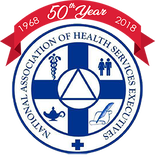President Past Messages - 2015
Desember 2015
NAHSE - National Association of Health Services Executives : 2013 - 2015
Progress Report as of November 30, 2015
By Steven Wilson, President (Servant), NAHSE, National Association of Health Services Executives

Dear NAHSE Members,
Two years ago, NAHSE had committed to a strategic planning process designed to prepare the organization for growth over the next 4 years and to respond to the rapidly changing healthcare environment. The plan was help ensure NAHSE’s ongoing value to minority healthcare leaders as they work to improve care delivery and population health. Based on input from the membership, chapter leaders and past presidents, the NAHSE Board developed this strategic plan to direct organizational focus over the four years.
Strategic Plan Development and Deployment Process
NAHSE conducts a systematic planning process to develop and deploy its strategic plan using a four-step methodology:
Below are a specific list of goals and outcomes of those goals that were established.
Goal 1: Member Growth Strategy
Develop and execute a member growth strategy and conduct a segmentation analysis to identify new growth opportunities. Develop a membership marketing campaign that articulates the value of NAHSE membership and develops messaging for targeted audiences.
Results: We effectively increased our overall membership any 33%, ending the year with 76 paid members and 5 institutional members for a total of 81 memberships.
Goal 2: Leadership Summits
Conduct industry-wide summits by gathering top thought leaders to identify healthcare trends and solutions for the field.
Results: NAHSE held nine (9) educational/membership meetings over the last 24 months. The average attendance average seventy-four (74) members and guests per event.
Goal 3: Website Redesign and Development.
The NAHSE Chicago website was revamped to attract more web traffic and appeal to the a ‘wider audience’. www.nahsechicago.com
Results: The new website was launched in February 2013. The monthly ‘audited’ web traffic is between 800 - 1200 ‘hits’ per month. We have seen as much as ‘3,000’ hits in some months!
Goal 4: Enhanced use of Technology to Support Goal Initiatives.
Results: We have instituted the following enhancements; 1) Online registration for all NAHSE Chicago events, 2) Online eCommence for payment for events, 3) Installation of ‘squares’ for transaction management & 4) electronic membership roster management.
Goal 5: Financial Stability.
Results: The chapter is financially sound, with the nationally recommended (6) months of expenses reserves in our fund account.
Goal 6: Scholarship Support.
Results: We were able to award three (3) separate scholarships to University of Illinois- Chicago, Rush University & Governors State University supporting their teams efforts to participate in the 2015 NAHSE National Student Case Competition.
Goal 7: NAHSE/Congress ‘Spring-fling’ to be Self-Supporting.
Results: We successful raised the needed funds to pay for the expenses associated with the NAHSE/Congress ‘Spring-fling’ event. We were able to make a ‘profit’ from this event as well.
Goal 8: Support NAHSE’s National Fundraising Events.
Results: We were able to support the NAHSE Career Transformation Center (CTC) program as well as send funds toward the annual conference to support the NAHSE National conference expenses.
As we continue down our strategic development path, I encourage all of our members to support our new President, Sherri Peavy by volunteering to chair committees or assisting as needed. Sherri is committed to continuing the strategic plan that she and our current NAHSE Chicago executive committee approved and executed. Please join me as NAHSE Chicago starts another successful chapter in our history.
Two years ago, NAHSE had committed to a strategic planning process designed to prepare the organization for growth over the next 4 years and to respond to the rapidly changing healthcare environment. The plan was help ensure NAHSE’s ongoing value to minority healthcare leaders as they work to improve care delivery and population health. Based on input from the membership, chapter leaders and past presidents, the NAHSE Board developed this strategic plan to direct organizational focus over the four years.
Strategic Plan Development and Deployment Process
NAHSE conducts a systematic planning process to develop and deploy its strategic plan using a four-step methodology:
- Collect data and analyze results
- Develop plan attributes and initiatives
- Operationalize the plan by deploying within the organization and with key partners
- Execute, monitor and adjust the plan as necessary
- Incorporate Mission, Vision and Values in everything that we do.
Below are a specific list of goals and outcomes of those goals that were established.
Goal 1: Member Growth Strategy
Develop and execute a member growth strategy and conduct a segmentation analysis to identify new growth opportunities. Develop a membership marketing campaign that articulates the value of NAHSE membership and develops messaging for targeted audiences.
Results: We effectively increased our overall membership any 33%, ending the year with 76 paid members and 5 institutional members for a total of 81 memberships.
Goal 2: Leadership Summits
Conduct industry-wide summits by gathering top thought leaders to identify healthcare trends and solutions for the field.
Results: NAHSE held nine (9) educational/membership meetings over the last 24 months. The average attendance average seventy-four (74) members and guests per event.
Goal 3: Website Redesign and Development.
The NAHSE Chicago website was revamped to attract more web traffic and appeal to the a ‘wider audience’. www.nahsechicago.com
Results: The new website was launched in February 2013. The monthly ‘audited’ web traffic is between 800 - 1200 ‘hits’ per month. We have seen as much as ‘3,000’ hits in some months!
Goal 4: Enhanced use of Technology to Support Goal Initiatives.
Results: We have instituted the following enhancements; 1) Online registration for all NAHSE Chicago events, 2) Online eCommence for payment for events, 3) Installation of ‘squares’ for transaction management & 4) electronic membership roster management.
Goal 5: Financial Stability.
Results: The chapter is financially sound, with the nationally recommended (6) months of expenses reserves in our fund account.
Goal 6: Scholarship Support.
Results: We were able to award three (3) separate scholarships to University of Illinois- Chicago, Rush University & Governors State University supporting their teams efforts to participate in the 2015 NAHSE National Student Case Competition.
Goal 7: NAHSE/Congress ‘Spring-fling’ to be Self-Supporting.
Results: We successful raised the needed funds to pay for the expenses associated with the NAHSE/Congress ‘Spring-fling’ event. We were able to make a ‘profit’ from this event as well.
Goal 8: Support NAHSE’s National Fundraising Events.
Results: We were able to support the NAHSE Career Transformation Center (CTC) program as well as send funds toward the annual conference to support the NAHSE National conference expenses.
As we continue down our strategic development path, I encourage all of our members to support our new President, Sherri Peavy by volunteering to chair committees or assisting as needed. Sherri is committed to continuing the strategic plan that she and our current NAHSE Chicago executive committee approved and executed. Please join me as NAHSE Chicago starts another successful chapter in our history.
Take Care Always!
Please also consider becoming a member of NAHSE, if you haven't done so already. 'JOIN TODAY' and expand your networking opportunities.
Steven Laineer Wilson
President (Servant) NAHSE Chicago
Please also consider becoming a member of NAHSE, if you haven't done so already. 'JOIN TODAY' and expand your networking opportunities.
Steven Laineer Wilson
President (Servant) NAHSE Chicago
OCTOBER 2015
International Fetal Alcohol Spectrum Disorders Awareness Day is September 9
Dear NAHSE Members:
Alcohol is now recognized as the leading preventable cause of birth defects and developmental disorders in the United States. Each year thousands of children are born with life-long disabilities because they were exposed to alcohol prenatally.
On September 9th, the National Institute on Alcohol Abuse and Alcoholism recognizes International Fetal Alcohol Spectrum Disorders (FASD) Awareness Day as a reminder that there is no “safe” level of drinking while pregnant.
“On the 11th anniversary of FASD Awareness Day, we from NAHSE’s CHICAGO chapter want to remind women of the importance of abstaining from alcohol to protect the health of their developing child,’. “FASD is still far too common and entirely preventable.” said Steven Wilson, President of NAHSE.
First recognized in 1999, International FASD Awareness Day helps raise awareness about the range of conditions that can result from alcohol use during pregnancy. Based on data from the Centers for Disease Control and Prevention, an estimated 1 in 8 women drinks during her pregnancy, putting her child at risk for a variety of issues including low IQ, learning disabilities, speech and language delays, behavioral problems, vision and hearing problems, and problems with vital organs, among others.
Alcohol can damage the developing fetal brain and is thought to be particularly harmful to the embryo and fetus during the first three months of pregnancy, a time when a woman may not even be aware she is pregnant. Because of this, it is recommended that women who are sexually active and not using birth control abstain from drinking, as well as women who are trying to become pregnant.
Alcohol is now recognized as the leading preventable cause of birth defects and developmental disorders in the United States. Each year thousands of children are born with life-long disabilities because they were exposed to alcohol prenatally.
On September 9th, the National Institute on Alcohol Abuse and Alcoholism recognizes International Fetal Alcohol Spectrum Disorders (FASD) Awareness Day as a reminder that there is no “safe” level of drinking while pregnant.
“On the 11th anniversary of FASD Awareness Day, we from NAHSE’s CHICAGO chapter want to remind women of the importance of abstaining from alcohol to protect the health of their developing child,’. “FASD is still far too common and entirely preventable.” said Steven Wilson, President of NAHSE.
First recognized in 1999, International FASD Awareness Day helps raise awareness about the range of conditions that can result from alcohol use during pregnancy. Based on data from the Centers for Disease Control and Prevention, an estimated 1 in 8 women drinks during her pregnancy, putting her child at risk for a variety of issues including low IQ, learning disabilities, speech and language delays, behavioral problems, vision and hearing problems, and problems with vital organs, among others.
Alcohol can damage the developing fetal brain and is thought to be particularly harmful to the embryo and fetus during the first three months of pregnancy, a time when a woman may not even be aware she is pregnant. Because of this, it is recommended that women who are sexually active and not using birth control abstain from drinking, as well as women who are trying to become pregnant.
|
Fetal Alcohol Spectrum Disorders are entirely preventable. As the ninth day of the ninth month of the year approaches, NIAAA reminds every woman to protect her unborn child’s well-being and not drink during the entire nine months of pregnancy.
Click for more information on FASD visit: Fetal Alcohol Exposure |
August 2015
NAHSE Chicago Salutes: National Childhood Obesity Awareness Month
 National Childhood Obesity Awareness Month
National Childhood Obesity Awareness Month
Dear NAHSE Family and Friends,
One in 3 children in the United States is overweight or obese. Childhood obesity puts kids at risk for health problems that were once seen only in adults, like type 2 diabetes, high blood pressure, and heart disease.
The good news? Childhood obesity can be prevented. Communities, health professionals, and families can work together to create opportunities for kids to eat healthier and get more active.
Make a difference for kids: Spread the word about strategies for preventing childhood obesity and encourage communities, organizations, families, and individuals to get involved.
How can National Childhood Obesity Awareness Month make a difference?
We can all use this month to raise awareness about the obesity epidemic and show people how they can take steps toward a solution.
Here are just a few ideas:
• Encourage families to make small changes, like keeping fresh fruit within reach or going on a family walk after dinner.
• Motivate teachers and administrators to make schools healthier. Help them provide healthy food options and daily physical activities for students.
• Ask doctors and nurses to be leaders in their communities by supporting programs to prevent childhood obesity.
Be Well!
Please also consider becoming a member of NAHSE, if you haven't done so already. 'JOIN TODAY' and expand your networking opportunities.
Steven Laineer Wilson
President (Servant) NAHSE Chicago
One in 3 children in the United States is overweight or obese. Childhood obesity puts kids at risk for health problems that were once seen only in adults, like type 2 diabetes, high blood pressure, and heart disease.
The good news? Childhood obesity can be prevented. Communities, health professionals, and families can work together to create opportunities for kids to eat healthier and get more active.
Make a difference for kids: Spread the word about strategies for preventing childhood obesity and encourage communities, organizations, families, and individuals to get involved.
How can National Childhood Obesity Awareness Month make a difference?
We can all use this month to raise awareness about the obesity epidemic and show people how they can take steps toward a solution.
Here are just a few ideas:
• Encourage families to make small changes, like keeping fresh fruit within reach or going on a family walk after dinner.
• Motivate teachers and administrators to make schools healthier. Help them provide healthy food options and daily physical activities for students.
• Ask doctors and nurses to be leaders in their communities by supporting programs to prevent childhood obesity.
Be Well!
Please also consider becoming a member of NAHSE, if you haven't done so already. 'JOIN TODAY' and expand your networking opportunities.
Steven Laineer Wilson
President (Servant) NAHSE Chicago
July 2015
NAHSE Chicago Salutes: National Women’s Health Week
Dear NAHSE Family and Friends,
National Women’s Health Week is an observance led by the U.S. Department of Health and Human Services Office on Women’s Health. The goal is to empower women to make their health a priority. The week also serves as a time to help women understand what steps they can take to improve their health.
The 16th annual National Women’s Health Week kicks off on Mother’s Day, May 10, and is celebrated until May 16, 2015.
What steps can you take for better health?
To improve your physical and mental health, you can:
Visit a doctor or nurse to receive regular checkups and preventive screenings.
• Get active.
• Eat healthy.
• Pay attention to mental health, including getting enough sleep and managing stress.
• Avoid unhealthy behaviors, such as smoking, texting while driving, and not wearing a seatbelt or bicycle helmet.
Find out what additional steps you should take based on your age. How can I participate in National Women’s Health Week?
The Chicago chapter of NAHSE invites women across the ‘Chicagoland’ area to:
• Spread the word through social media. Use the #NWHW hashtag.
• Learn what steps you should take for good health based on your age, weight and ‘hook a sista up’ by checking in on your sister, mother or friend.
Be Well!
Please also consider becoming a member of NAHSE, if you haven't done so already. 'JOIN TODAY' and expand your networking opportunities.
Steven Laineer Wilson
President (Servant) NAHSE Chicago
National Women’s Health Week is an observance led by the U.S. Department of Health and Human Services Office on Women’s Health. The goal is to empower women to make their health a priority. The week also serves as a time to help women understand what steps they can take to improve their health.
The 16th annual National Women’s Health Week kicks off on Mother’s Day, May 10, and is celebrated until May 16, 2015.
What steps can you take for better health?
To improve your physical and mental health, you can:
Visit a doctor or nurse to receive regular checkups and preventive screenings.
• Get active.
• Eat healthy.
• Pay attention to mental health, including getting enough sleep and managing stress.
• Avoid unhealthy behaviors, such as smoking, texting while driving, and not wearing a seatbelt or bicycle helmet.
Find out what additional steps you should take based on your age. How can I participate in National Women’s Health Week?
The Chicago chapter of NAHSE invites women across the ‘Chicagoland’ area to:
• Spread the word through social media. Use the #NWHW hashtag.
• Learn what steps you should take for good health based on your age, weight and ‘hook a sista up’ by checking in on your sister, mother or friend.
Be Well!
Please also consider becoming a member of NAHSE, if you haven't done so already. 'JOIN TODAY' and expand your networking opportunities.
Steven Laineer Wilson
President (Servant) NAHSE Chicago
April 2015
Healthiest Nation in One Generation!
|
Dear NAHSE Family and Friends,
This month let’s celebrate our accomplishments and talk about what it will take to become the Healthiest Nation in One Generation! 2015 marks the 20th anniversary of APHA coordinating National Public Health Week! The accomplishments of the public health community over the last two decades are significant. To become the Healthiest Nation in One Generation: experts need to support the integration of public health and primary care; policy decision makers need to understand and support funding for both a strong public health workforce and prevention programs proven to advance health; both national and local policy decision makers need to expand the consideration of health implications in all the policies they create; and the general public needs to make healthy choices for themselves and demand that everyone has an equal opportunity to make those same choices. |
|
Facts & Stats:
Some of the greatest public health achievements of the 20th Century – according to the CDC (and I agree!) include:
• Healthier Mothers & Babies – Infant and maternal mortality rates have decreased in the U.S. Environmental interventions, improvements in nutrition, advances in clinical medicine, improvements in access to health care, improvements in surveillance and monitoring of disease, increases in education levels, and improvements in standards of living contributed to this remarkable decline.
• Immunizations – Today, U.S. vaccination coverage is at record high levels! National efforts to promote vaccine use among all children has helped eradicate Smallpox and dramatically decrease the number of cases of Polio, Measles, Hib and other diseases in the U.S.
• Motor Vehicle Safety – We’ve seen a huge reduction in the rate of death attributable to motor vehicle crashes in the United States, which represents the successful public health response to a great technologic advancement (the motorization of America). The response has spanned government, public health and driver and passenger behavior.
• Family Planning – Increased contraception use, public health education and other factors mean that, today, Americans face fewer unintended pregnancies and are far more likely to achieve desired birth spacing and family size.
• Tobacco as a Health Hazard – During 1964-1992, approximately 1.6 million deaths caused by smoking were prevented thanks to substantial public health efforts.
Decline in Deaths from Heart Attack & Stroke – Still the country’s top killers, the public health community has helped achieve remarkable declines in deaths from both diseases: since 1950, deaths from cardiovascular disease have declined 60 percent, and stroke rates have declined 70 percent. NAHSE Chicago supports the efforts of on exceptional FQHC’s and community-based hospitals that assist the ‘underserved’ in our communities.
Please also consider becoming a member of NAHSE, if you haven't done so already. 'JOIN TODAY' and expand your networking opportunities.
Steven Laineer Wilson
President (Servant) NAHSE Chicago
Some of the greatest public health achievements of the 20th Century – according to the CDC (and I agree!) include:
• Healthier Mothers & Babies – Infant and maternal mortality rates have decreased in the U.S. Environmental interventions, improvements in nutrition, advances in clinical medicine, improvements in access to health care, improvements in surveillance and monitoring of disease, increases in education levels, and improvements in standards of living contributed to this remarkable decline.
• Immunizations – Today, U.S. vaccination coverage is at record high levels! National efforts to promote vaccine use among all children has helped eradicate Smallpox and dramatically decrease the number of cases of Polio, Measles, Hib and other diseases in the U.S.
• Motor Vehicle Safety – We’ve seen a huge reduction in the rate of death attributable to motor vehicle crashes in the United States, which represents the successful public health response to a great technologic advancement (the motorization of America). The response has spanned government, public health and driver and passenger behavior.
• Family Planning – Increased contraception use, public health education and other factors mean that, today, Americans face fewer unintended pregnancies and are far more likely to achieve desired birth spacing and family size.
• Tobacco as a Health Hazard – During 1964-1992, approximately 1.6 million deaths caused by smoking were prevented thanks to substantial public health efforts.
Decline in Deaths from Heart Attack & Stroke – Still the country’s top killers, the public health community has helped achieve remarkable declines in deaths from both diseases: since 1950, deaths from cardiovascular disease have declined 60 percent, and stroke rates have declined 70 percent. NAHSE Chicago supports the efforts of on exceptional FQHC’s and community-based hospitals that assist the ‘underserved’ in our communities.
Please also consider becoming a member of NAHSE, if you haven't done so already. 'JOIN TODAY' and expand your networking opportunities.
Steven Laineer Wilson
President (Servant) NAHSE Chicago



